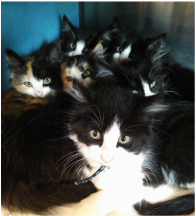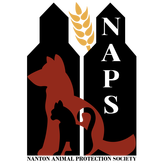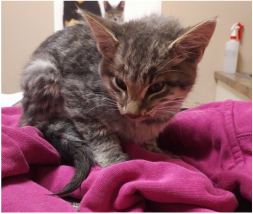 Nanton - a beautiful southern Alberta town of 2100 people located on the edge of the foothills. Sounds like a great place right? Well let's say each of those 2100 people had one cat. That's a lot of cats, but let's take it one step further and say that 5% of those cats are not spayed or neutered. Now what happens to that original number? On average a female cat of reproductive age (6 months) will have four kittens per litter. And 2-3 litters per year. That mother cat and her kittens are capable of producing up to 420,000 kittens in seven years. Sounds almost unimaginable. Well that community of 2100 people would quickly become a community of 2100 people and 5800 cats in 1 year if only 5% were unaltered (spayed/neutered). Unfortunately it is very common. What We Know Research shows that on average in Canada in 2011 there were 10.2 million cats owned. This equates to about one owned cat for every three Canadian residents. 37.7% of all Canadian households owned a cat with an average number of 1.9 cats per household. Based on market research 80% of owned cats have been sterilized, leaving 20% unaltered. However, while Canadians enjoy cat ownership, conservatively more than 150,000 cats were surrendered to shelters in 2011. More alarmingly, when data on Homeless-Sheltered cats that did not find a new home is extrapolated to include all potential shelters it is more likely that 638,875 cats in Canada languished - either waiting in shelters or facing euthanasia. This is where the cat overpopulation problem and the crisis facing those looking after the problem becomes very real. What Is The Solution? At this point, if large-scale, targeted action is not taken, the cat overpopulation problem will worsen. There is no one person or group responsible for the problem or finding the solution – it is truly a community problem that requires a community effort to resolve. To significantly reduce cat overpopulation in Canada the Canadian Federation of Humane Societies urges shelters, municipalities, rescues, TNR groups, veterinarians, all communities and any individual who values cats to take the steps necessary to reduce the cat overpopulation problem starting with: • Accessible spay/neuter surgeries • Increased adoption strategies • Humane education • Adequately funded enforcement • Responsible pet ownership If these steps are not taken, a community will be faced with not only a rapid increase in the cat population but also with the surrounding consequences. Some of those consequences include;
What Can YOU Do To Help? Research shows that Road traffic accidents (RTAs) are a common cause of injury and death for outdoor-access cats. Olsen and Allen (2001) found that 51% of outdoor-access cats that suddenly and unexpectedly died were the result of RTAs, and Rochlitz et al. (2001) found that RTAs were the fourth most common cause of death for cats after old age, cancer, and renal failure. This research is based upon a 'controlled' population of cats. One can only imagine how much high that statistic would be if the population was out of control. To prevent needless feline deaths, NAPS encourages cat owners to keep their cats indoors, or outdoors only with supervision or the aid of cat leashes. Some people even use Cat Aviaries built off a window or door in their home. Another way to help reduce needless suffering of felines in Nanton is to ensure that any outdoor cats you have are sterilized. As mentioned above, stray and feral populations can grow to unmanageable numbers in no time. You can help ease the burden on Nanton by preventing your cat from adding to our stray/feral population. What NAPS Is Doing Our volunteers and affiliated veterinary clinics have been working tirelessly for years to have a meaningful impact on the stray/feral population in Nanton. Our TNR (trap/neuter/release) program takes in close to 80 cats and kittens annually. When these cats cant be adopted out to loving families, we will sterilize them, tattoo them and release them on co-operating farms or back into town. We have the financial resources and the dedication to take on even more stray/feral animals annually. BUT we lack an adequate facility to process more animals than we already are. We are actively raising funds to build a facility which could help us have an even larger impact on this community. At this time, the Town of Nanton Council has not been able to provide us with a suitable land lease option, but has repeatedly entertained proposals. A recent effort to purchase town own land was rejected by council as well. Stay tuned for a future blog post which will detail our search for a home. Are There Benefits to Feral Colonies In Town? An established, stable, sterilized and vaccinated colony will deter other stray cats from moving into the area. This decreases the risk that residents and their pets will encounter an unvaccinated/unaltered animal and will virtually eliminate behaviors such as fighting, spraying and yowling. Cats vaccinated for Rabies create a buffer zone between wildlife and the public which greatly reduces Nantons residents risk of contracting Rabies. Feral cats also help keep the rodent population under control. They wont hunt them into extinction but they will keep the numbers low and prevent more rodents from moving into the area. Lastly, a healthy cat colony can help ease the burden on area shelters, greatly reducing the number of animals housed in shelters which has a positive impact on shelter animals quality of life and overall health. It is also statistically shown that non crowded shelters have higher adoption rates. HELP US Spread The Word NAPS needs your help to get this message across to Nanton residents and Town of Nanton officials.
Show your support for NAPS and our efforts to keep Nanton a healthy and safe place for all its residents and their pets. This blog post was written by Kristen Mills - Veterinary Technician/NAPS Director & Kim Williamson - NAPS Director/Shelter Manager
3 Comments
Rick Everett
8/19/2016 08:22:59 am
Over the past number of years, The Town of Nanton has worked with the Nanton Animal Protection Society to assist them in finding a suitable location for their new facility.
Reply
7/8/2017 11:42:09 pm
Please feel free to check out our outdoor cat trees! It would be great if you can take a look? Let me know your thoughts https://cattree.uk/outdoor-cat-trees-uk/
Reply
Mahendrasingh Adhikari
10/15/2023 06:43:53 am
Your blog post was thought-provoking and well-argued. I enjoyed the way you presented your ideas and supported them with evidence and examples. To gain further knowledge on this subject, <a href="https://aquapeace24.com/text.php#aff=mahendramahi3113" target="_blank">click here</a>.
Reply
Leave a Reply. |
Details
AuthorThe NAPS Blog features posts from various contributors in the animal industry. We hope to use the blogsite as a way to help educate Nanton and area residents, and share our love of animals with them. ArchivesCategories |


 RSS Feed
RSS Feed